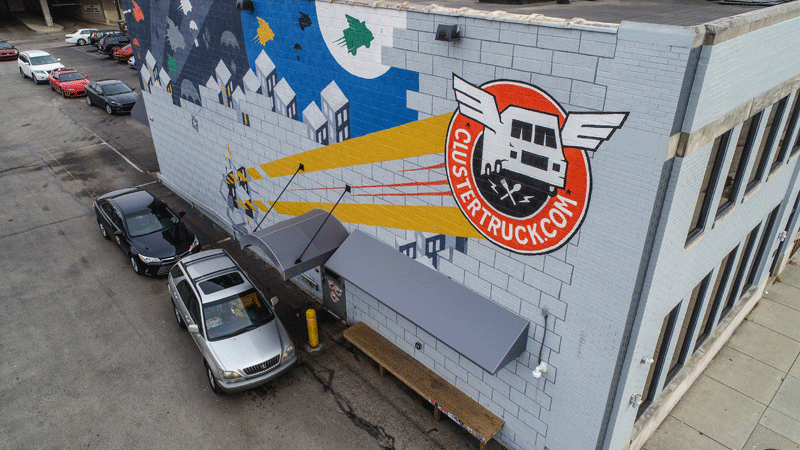Chris Baggott, the founder and CEO of ClusterTruck, said after many, many conversations with restaurant owners, he found what might be the ideal ghost kitchen partner in grocery giant Kroger.
ClusterTruck, the “virtual food truck” that offers everything from pad Thai to hamburgers out of four vertically-integrated delivery-only kitchens, and the largest grocery chain in the U.S. will partner to expand the reach of the delivery operations.
Baggott founded ClusterTruck in 2015 as the delivery world was taking flight. He saw the blend of high-fees, low margins and third party complexity as an affront to the traditional restaurant and a more holistic way to make delivery work. As he describes, the ghost kitchens and the delivery are fully integrated. ClusterTruck employees make the food, a network of ClusterTruck gig-workers then pick it up and deliver it within a seven-minute driving radius. And the whole thing is driven by sophisticated, machine-learning software to perfectly time each menu item in an order so the driver can drive up, grab the food, and hand it off to the customer at the curb in under 10 minutes.
Essentially, Kroger will bring its branding to the four existing ClusterTruck facilities in Indianapolis, Columbus, Ohio, Kansas City, Missouri, and in Denver under the King Soopers—a sub-brand of Kroger. Together, the partners will open a fifth location in Carmel, Indiana. ClusterTruck employees will continue to operate all the locations.
He said the pivot toward the grocery industry came after a lot of restaurant owners just didn’t see how the ClusterTruck model would work with a traditional restaurant group.
“We’ve been trying to talk to restaurant operators for a year about how to get out of third-party and into this system, they just have not been able to get out of their own way,” said Baggottt. “For the most part, everyone that I’ve talked to—and I’ve talked to a lot of people—they’re very hung up on their brands.”
While the concept, restaurant owners often didn’t like the idea of multiple cuisines.
“I say you have to make pad Thai, but they said, ‘We’re not a pad Thai restaurant,’” said Baggott. “But that doesn’t matter if the customer wants pad Thai.”
He said the conversations continually remind him of what Sears was doing in 1997, which he listed in his very first inspirations for the company.
“My first investor deck I showed a logo of Sears, when the Internet started Sears was a Fortune seven company when the internet started in 1997,” said Baggott. “They had all the tools, but online was incremental. They had the fulfillment center, but it was always a side business for them. All these companies that should have won online but didn’t because it was always an incremental part. The way we’ve tackled this is making it a primary focus.”
So Baggott thought, maybe groceries would be a fit. They are continually ramping up prepared food, they have kitchens and supply-chain logistics and they’re expanding quickly into the convenience economy. And, of course, the largest operator in the U.S. just happened to be willing to take the plunge.
“What I admire about Kroger, hey are so willing to be the disruptor. You take this all the way back to the consumer, and this I what we’ve proven with ClusterTruck, we can deliver faster, it’s better and fresher because we have our own drivers and cook everything just in time,” said Baggott.
And the operating costs, he said, are especially noteworthy, with customer-facing coming in at below 10 percent of costs with no delivery fee, fast deliveries and no front of house costs at all. That’s “cheaper than a waitress” according to Baggott.
The model was intriguing to Kroger, and since the two companies began discussing a partnership about nine months ago, things have sped along. Kroger chief information officer Yael Cosset said the partnership is another step toward what today’s consumers want.
“The way our customers order and receive meals is evolving, and ClusterTruck’s innovative culinary and digital design is cracking the code for the future of profitable meal delivery,” said Cosset, in a press release announcing the deal. “Kroger is leveraging ClusterTruck’s advanced technology to ensure our customers don’t have to sacrifice quality and value for convenience when it comes to meal delivery. Kroger Delivery Kitchen Powered by ClusterTruck will allow our customers to access restaurant-quality fresh and delicious meals like never before and without having to pay excessive service or delivery fees.”
A key aspect is Kroger’s incredible marketing reach. With 11 million customers flowing through Kroger grocery stores each day, it expands the marketing potential drastically. That’s an area where Baggott admits ClusterTruck has difficulties. Because the kitchens have limited or no visibility, getting the word out requires intense marketing efforts before the flywheel of repeat orders really gets up to speed.
But in Indianapolis, the initial location for the brand, ClusterTruck sees 90 percent repeat orders. He said the trick has been opening kitchens, with a significant equipment and technology outlay, it’s been a balancing act of aggressive marketing and growth. But Kroger helps on both fronts.
“The hindrance to our growth has been having to open kitchens,” said Baggott. “We know we have the winning platform. Our delivery costs are under 10 percent and the food is high quality—that’s magic. And our customer is incredibly loyal.”
The newest location is a second-generation space with a 2,000 square foot kitchen. Baggott said they would measure everything in the initial phase of this partnership, and ponder what the next phase might look like, be it kitchens inside a grocery store or more standalone locations.


